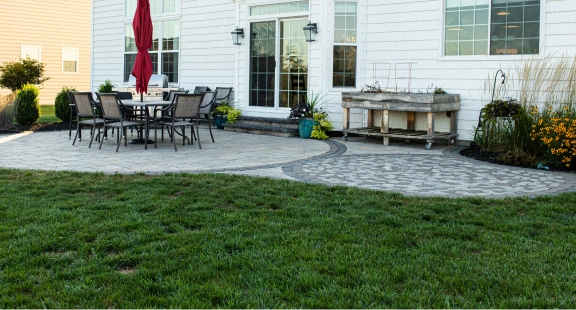With the widespread drought, high temperatures, and rising water prices, how much does it cost to water a lawn has never been a more important question for lawn owners.
An adequate watering system keeps your lawn healthy, pest-free, and vivid green, as one of the top features of your landscape. Understanding the water amount needed for your lawn allows you to plan your budget accordingly and adopt water-saving practices.
To determine how many gallons of water to water lawn is optimal, and what it costs, evaluate the size of the lawn, your watering system, the climate, and several other factors.
Before we move on to the lawn watering cost calculator, let’s explore various factors influencing water consumption and cost.
Factors That Affect the Cost of Watering a Lawn
Knowing the approximate irrigation cost per square foot ensures you use your resources well, don’t waste water, and maintain a healthy lush lawn without the massive financial strain. Here are the factors to understand.
- Lawn Size
Large lawns need more water for healthy irrigation. However, the more square footage your lawn covers, the more complex it gets to ensure good water distribution. Investing in a quality irrigation system to spread the water evenly may increase the initial costs, but save water over time.
- Local Water Rates
The price you’ll have to pay to maintain a lush lawn varies across the regions and can be influenced by water scarcity, available infrastructure, or treatment processes.
For example, some regions have a tiered pricing cost structure, meaning that the water price increases with the consumption rise. Other regions include different fees for services, including:
- Meter reading
- Wastewater treatment
- Environmental surcharges
- Seasonal fees for peak season from May to September
For example, most municipalities in Pennsylvania have adopted a volumetric system, so people pay the amount of water they have consumed with a flat rate.
- Watering Frequency
How often you’ll need to water your lawn depends on the amount of rainfall your area gets, the season of the year, and the grass type.
For example, Pennsylvania spring seasons are typically rainy with warm temperatures, and high moisture levels which may reduce the frequency of lawn watering. Similarly, drought-tolerant grass types, such as Bermuda grass are excellent options if you want to cut the watering and save money.
In Pennsylvania in early spring you can water your Bermuda grass lawn two times per week and gradually increase the frequency as the temperatures rise.
- Watering Method
The watering method directly affects the average irrigation water usage with its efficiency. Understand the differences between sprinkles, drip, and hand watering methods to reduce lawn irrigation cost without compromising lawn health.
- Sprinklers – easy to install on large areas, but prone to water waste; water usage is moderate to high
- Drip irrigation system – efficient system which delivers water to the roots, reducing water waste; water usage is low
- Hand watering – suited for smaller lawns and targeted watering; low water consumption and waste, but labor-intensive
- Irrigation System Efficiency
The irrigation system efficiency directly influences water usage. For example, modern systems have adjustable low-flow nozzles and soil moisture sensors to ensure the lawn gets only the water it needs when it needs it.
Older irrigation systems rely on user commitment to navigate irrigation and handle water usage, which leads to inefficiency, overwatering, and higher water usage.
With leak-detecting sensors, modern systems inform you immediately of malfunctions to reduce waste. On the other hand, sometimes there could be days and weeks before you’ll notice issues with the older system.
- Climate and Weather Conditions
During drought, you’ll have to water your plants more frequently and abundantly to ensure their health. Excessive rainfall lowers your water usage but increases the risk of water runoff, waterlogged soil pests, and diseases.
To experience the most benefits of rainfall, ensure good drainage of the soil.
- Soil Type
Understanding different soil type and their moisture needs helps you understand how much it cost to water your lawn:
- Sandy soils – Require frequent watering due to poor water retention leading to increased water consumption and bills
- Clay soils – Need less frequent watering and have excellent water retention, but there is a risk of water logging so caution is advised
- Loamy soils: Moderate watering consumption due to balanced water retention
Calculating the Cost of Watering a Lawn
Follow the next formula to determine the amount of water you need for your lawn, considering its size and the watering depth:
| Lawn size (expressed in square feet) x Watering depth (expressed in inches) x 0,623 (conversion factor for converting cubic feet to gallons = Water usage |
For most lawns, the recommended watering depth is around one inch, so here is a lawn water usage calculator method for a 5,000 square feet lawn:
5,000 square feet x 1 in x 0.623 = 3,115 gallons per week
So if you wonder how much water to irrigate 1 acre of grass you need weekly, apply the formula and you’ll get around 22,703 gallons of water. To find out the cost to irrigate 1 acre or whatever your lawn size is, contact your local water supplier to learn the rates or analyze your average water bill.
- Total Cost Estimation
Once you have the average amount of water needed for your lawn, multiply it with your local rates to get the cost.
Don’t forget to consider the seasonal differences in water needs to calculate the cost of watering the lawn per year. For example, during the rainy season, your water usage will decrease, but extreme drought can increase the consumption beyond expected. Therefore, check the weather forecast
Water-Saving Tips to Reduce Costs
There are a few methods you can use to save water and be kinder to the environment and your wallet.
Smart irrigation systems
These are equipped with smart and easily accessible controllers that offer customized watering based on weather conditions instead of rigid schedules. They are great for reducing sprinkler water usage during seasonal weather changes.
Watering at Optimal Times
Next, you can enhance the efficiency of your watering system by tailoring the watering time to reduce evaporation and water waste. For most climates, watering in the early morning and late evening works the best.
Select Grass carefully
Research which grass types are best for your climate and weather conditions and focus on drought-tolerant varieties. That way, you’ll minimize water consumption without compromising the appearance of your lawn.
Maintain the Lawn Well
Adopt lawn maintenance practices including:
- Aeration
- Property and timely mowing
- Fertilization
- Pest control
That will maximize moisture absorption and lower the water waste resulting in reduced water needs and lower water bills.
Prioritize Sustainable Practice
Invest in rainwater harvesting methods and connect them with your sprinkle system. Here is how you can do that:
- Choose a suitable location such as a roof for rainwater collection
- Install a flush diverter and filter to reduce the risk of contaminants and system clogging with debris and dirt
- Choose an adequate storage tank
- Do the plumbing work to ensure correct to minimize leaks and water waste
- Clean the pipes regularly to prevent clogging and replace filters occasionally
The Environmental Impact of Lawn Watering
Even a tiny reduction of the average sprinkler water usage makes a huge difference considering how much water it can for a few years. That way, you can be a part of eco-conscious cultural groups looking to preserve local water supplies.
The alternatives to traditional laws requiring increased sprinkler coverage area include:
- Prioritizing drought-tolerant plants
- Choosing alternative gardens such as Xeriscapes
- Water-efficient nozzles
- Smart sensor technology for detecting moisture levels and automating the watering schedule
- Raising awareness of the importance of water conservation
Key Takeaways
The bigger the lawn is, the more water you’ll need to keep it healthy and the more money you’ll have to pay for that lush green color and healthy grass.
However, modern gardening has reached the point where you can choose drought-tolerant and resilient plants, harvest rainwater, and invest in top-notch irrigation systems that will reduce water consumption.
Your wallet and the environment will thank you, and your lawn won’t lose anything of its beauty!
Have you tried low-flow nozzles, or are you ready to replace your dated irrigation system with modern sprinklers?
FAQ
What is the most budget-friendly method to irrigate the lawn?
Hand-watering is cheap, but it may not be the most efficient in the long run or for the larger lawns. Drip irrigation provides long-term money savings because of the reduced water usage, efficient water delivery, and located watering.
When is lawn irrigation cost the lowest in the year?
Winter months bring significant water consumption decreases. You can use the money you save on water consumption to invest in smart watering technology.
How do I know I am over-watering my lawn?
Inspect the soil for mushy texture, and check if the grass has turned yellow, as two safe signs of overwatering. Root rot, fungal diseases, and ponding water are signs that you have severely over-watered your lawn. Allow the soil to drain before you continue with lawn maintenance.
Is there a way to prevent water waste and reduce irrigation cost per square foot?
First, determine adequate water irrigation depth by finger test or a soil moisture probe. Then, adjust your irrigation system to prevent waste and invest in a more efficient system with controllable nozzles and customizable schedules.

